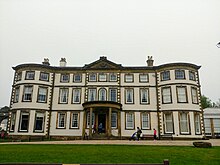Sewerby
This article includes a list of general references, but it lacks sufficient corresponding inline citations. (February 2020) |
| Sewerby | |
|---|---|
 St John the Evangelist Church | |
Location within the East Riding of Yorkshire | |
| OS grid reference | TA199688 |
| Civil parish | |
| Unitary authority | |
| Ceremonial county | |
| Region | |
| Country | England |
| Sovereign state | United Kingdom |
| Post town | BRIDLINGTON |
| Postcode district | YO15 |
| Dialling code | 01262 |
| Police | Humberside |
| Fire | Humberside |
| Ambulance | Yorkshire |
| UK Parliament | |
Sewerby is a village in the East Riding of Yorkshire, England approximately 1 mile (1.6 km) north-east of Bridlington on the North Sea coast.
Sewerby forms part of the civil parish of Bridlington.
Sewerby is home to one of the East Riding's most popular tourist attractions, Sewerby Hall. The hall is a Grade I listed building[1] and is home to the Museum of East Yorkshire, including a room dedicated to the aviator, Amy Johnson.
The church dedicated to St John the Evangelist was designated a Grade II* listed building in 1976 and is now recorded in the National Heritage List for England, maintained by Historic England.[2]
History
Sewerby is mentioned in the Domesday Book; "In Siwardbi, Carle and Torchil had two manors, of six carucates and a half. It is now waste." This indicates the origin of the name: It was the (by) abode of Siward. (This is a Danish personal name, and one who bore it was the Governor of Northumbria). And, that Sewerby had two manors which were owned by Carle and Torchil, though no subsequent reference deals with more than one. And finally, that after William put down the English revolt in 1069, much of the land was now waste.[citation needed]

The two manors, formally owned by Carle & Torchil, were passed down in 1086 to Robert Count of Mortain and the Earl of Cornwall, the half-brother to William the Conqueror. Though, in the year 1088 Count Robert had his estate confiscated. There is no record of the fate of Robert's under-tenant, Richard de Surdeval, though it is possible his family survived as the de Sywardbys, using the name of the village.
The estate of Mortain passed to the Paynel family and then on to the archbishops of Canterbury. The land was held for them by the Meynells. The Meynells then granted land to Osbert de Sywardby sometime in the 1170s.
The de Sywardbys appear to have owned most of the land around Sewerby and Marton. Their position strengthened by marriages with the de Martons and the de Bucktons and during the 14th century 3 generations of the de Sywardby family were knighted.

In 1234 Robert de Sywardby held 3 carucates of land with William de Sywardby holding 4 carucates by 1299. Robert of Sewerby was lord of the manor in 1316 and the family held it until the death of William de Sywardby in 1452. Williams's daughter held the land until her son sold the land to Ralph Raysing in 1545 and so the estate finally passed out of the hands of the descendants of Osbert de Sywardby after nearly 400 years. In the same year Raysing also bought other properties in Sewerby. Raysing held the land until 1567 when he sold it to John Carliell.

The Carliell family held the land until 1714 when it was sold to John Graeme. John Graeme was actually living in the manor house when he bought the land. It is said that John and his son Robert made their fortunes by acting as agents for a Lady Boococke, a considerable landowner in Bridlington. Sewerby House was almost re-built by John Graeme between the years 1714 & 1720. There are however traces of the old house still to be seen inside the hall, most notably the Tudor doorway in the seem-basement.
The village of Sewerby (as spelt through the ages)
1086 Siuuardbi, Siward Bi
1284 Sywardby
1312 Siwardeby, Sywardeby, Syuuardby
1315 Seuerdby, Siwardeby, Sywardby
1346 Sywardeby
1650 Sewrby
Notable residents
- Helene Palmer (1928–2011), actress who portrayed Ida Clough on Coronation Street.[3]
- Frances Crawshaw (1876–1968), painter and botanical artist.[4]
References
- ^ Historic England. "Sewerby House (1367122)". National Heritage List for England. Retrieved 29 April 2013.
- ^ Historic England. "Church of St John the Evangelist (1083693)". National Heritage List for England. Retrieved 18 August 2013.
- ^ Thursby, Keith (13 January 2011). "Corrie star bows out". Bridlington Free Press. Retrieved 25 January 2011.
- ^ Gray, Sara (2019). British Women Artists. A Biographical Dictionary of 1000 Women Artists in the British Decorative Arts. Dark River. ISBN 978 1 911121 63 3.
- Gazetteer — A–Z of Towns Villages and Hamlets. East Riding of Yorkshire Council. 2006. p. 10.

